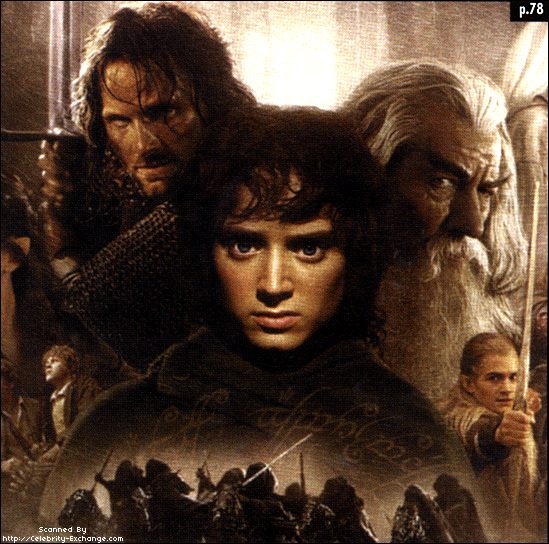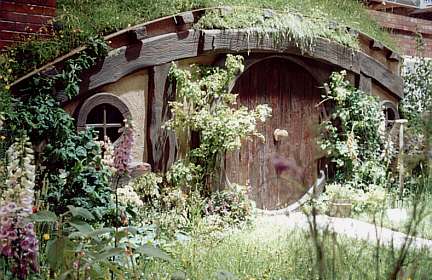THE RED BOOK OF WESTMARCH
THE LORD OF THE RINGS IN
THREE VOLUMES AND SIX BOOKS
THE RED BOOK OF WESTMARCH
THE LORD OF THE RINGS IN
THREE VOLUMES AND SIX BOOKS
PROFESSOR TOLKIEN was fortunate enough to come into possession of a copy of THAIN'S BOOK, derived from THE RED BOOK OF WESTMARCH containing the memoirs of Messers. Bilbo, Frodo and Sam, most respectable residents of the Shire in Middle Earth. Together with Bilbo's TRANSLATIONS OF THE ELVISH, we know of the events described in THE HOBBIT and LORD OF THE RINGS...
As an Anglo-Saxon scholar, Tolkien was quick to appreciate the epic grandeur of what he studied. We cannot be surprised, then, to know that along with Beowulf, The Iliad and Odyssey, The Aeneid, and Paradise Lost, there are conventions and archetypes inherent in oral and written epic poetry, and it is with these and the pages on this site thus far with which we will begin our quest. The following epic characteristics are noteworthy:
1. epic-similes / kennings and metaphors, and alliteration patterns
2. the use of epithets or tags
3. formula theory of composition
4. ring structure--Beowulf
5. Invocation to the muse
6. begins in medias res
7. a descent to the underworld
8. the arming of the hero
9. personification of weapons
10. the hero's quest and return
11. deus ex machina
12. interlacing motifs such as the M, S, G alliteration patterns in Beowulf.
13. family histories
14. a socio-moral perspective--honor
To quote Lt.-Commander Worf, whose Klingon weltanschauung is not unlike the warrior code of Homer and the Beowulf poet, "These are our stories; they tell us who we are!"
Some preliminaries as noted by Albert Lord, ("The Return Song") and Austin Hatch, ("The Epic Hero") with interlaces to Tolkien by Raymond Nighan...These comments will prove useful in determining the "epic hero" of the quest in Volume VI.
1. The epic hero's adventures is lauded orally, and then written down as with Beowulf and The Red Book. Recall Sam wondering more than once whether anyone would recount their deeds, especially on the slopes of Mount Doom.
2. His homecoming is long awaited by those left behind, and by the participation. Frodo and Sam frequently think of the Shire in moments of greatest despair.
3. He is lost at sea, reaches land, is discovered, enters a foreign assembly disguised, learns culture (games/dance/stories), and is taunted until he reveals his identity and tells his story.--We know that the company is split: Merry and Pippin are taken by Orcs, Gandalf seems to be dead, and Boromir is, Aragorn, Legolas and Gimli does not know where Frodo and Sam are. They bring their culture and frequently rely on its sustaining power, Sam being inside a song, and seeing one lonely star in the midst of doom.
4. After combat he sails for home, is immature, continues to thwart injustice, angers the gods ), displays heroic powers, escapes death, avoids complacency, earns a rest but shuns it, journeys to the underworld, receives prophecy and instruction , prepares, is set apart, and attempts to control nature. Much of this dominates the Trilogy. The Shire must be scoured (cleansed), how many times do Frodo and Sam escape death--and how do they?, controlling nature in Tolkien cannot really be done. His romanticism demands it be restored and cleansed of the evil that results when man attempts control, usually by "infernal combustion engines." Gandalf and the elves serve as mentors.
5. Additionally, the epic hero: learns humility, suffers alone, (splendid isolation), and brings the story back to beginning. At the beginning of the quest, Frodo feels that he wants to save the Shire, but feels very small and uprooted. Upon the return, he of course cannot stay in the Shire--his wound has to a degree faded him,
6.The gods reveal their favor, the hero enters unrecognized, is welcomed in disguise, gains retribution in battle, and achieves reconciliation and reunion. The ring is destroyed and Middle Earth saved.
a--absence--hobbits generally do not like to travel. Biblo is considered odd for so doing, and Frodo wonders if he will every see Hobbiton again?
b--devastation--especially of nature, symbolic of the moral values Tolkien valued
c--return--the Hobbits come home, but....
d--retribution--the Shire must be cleansed--Recall what Tolkien said about evil.
e--marriage (reconciliation of opposites--Coleridge)--What happens to Sam?
8. Some themes and motifs to note in LOTR:
BOOK ONE:
(NOTE THAT MAJOR CHARACTERS--ESPECIALLY FRODO AND SAM-- IF NOT
LISTED--ARE INVOLVED IN MOST CATEGORIES; CHRISTIAN THEMES ARE LIKEWISE IMPLIED)
|
FOR THE GIVEN
CHAPTERS, FIND EXAMPLES OF WHAT IS PROVIDED ON THE LEFT... 1. 2. 3. 4. 5. 6. 7. 8. 9. 10. 11. 12. ADD ADDITIONAL IDEAS OF YOUR OWN FROM BOOK ONE... |
||||||||||||||||||||||||||||||||||||||||
BOOK TWO:
|
FOR THE GIVEN CHAPTERS, FIND EXAMPLES OF WHAT IS PROVIDED ON THE LEFT... 1. 2. 3. 4. 5. 6. 7. 8. 9. 10. ADD ADDITIONAL IDEAS OF YOUR OWN FROM BOOK TWO... |
||||||||||||||||||||||||||||||||||||||||||||||||||||
BOOK THREE:
|
FOR THE GIVEN CHAPTERS, FIND EXAMPLES OF WHAT IS PROVIDED ON THE LEFT... 1. 2. 3. 4. 5. 6. 7. 8. 9. 10. 11. ADD ADDITIONAL IDEAS OF YOUR OWN FROM BOOK THREE... |
|||||||||||||||||||||||||||||||||||||||||||||||||||||||||
BOOK IV
|
FOR THE GIVEN CHAPTERS, FIND EXAMPLES OF WHAT IS PROVIDED ON THE LEFT... 1. 2. 3. 4. 5. 6. 7. 8. 9. 10. 11. ADD ADDITIONAL IDEAS OF YOUR OWN FROM BOOK FOUR... |
|||||||||||||||||||||||||||||||||||||||||||||||||||||
BOOK V:
|
FOR THE GIVEN CHAPTERS, FIND EXAMPLES OF WHAT IS PROVIDED ON THE LEFT... 1. 2. 3. 4. 5. 6. 7. 8. 9. 10. ADD ADDITIONAL IDEAS OF YOUR OWN FROM BOOK FIVE... |
|||||||||||||||||||||||||||||||||||||||||||||||||||||
 |
||||||||||||||||||||||||||||||||||||||||||||||||||||||
BOOK VI:
|
FOR THE GIVEN CHAPTERS, FIND EXAMPLES OF WHAT IS PROVIDED ON THE LEFT... 1. 2. 3. 4. 5. 6. 7. 8. 9. ADD ADDITIONAL IDEAS OF YOUR OWN FROM BOOK SIX, AND ANY GENERIC OBSERVATIONS YOU HAVE... |
|||||||||||||||||||||||||||||||||||||
 |
||||||||||||||||||||||||||||||||||||||